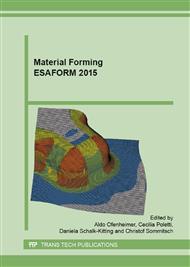[1]
G. Avramovic-Cingara, Y. Ososkov, M.K. Jain, D.S. Wilkinson, Effect of martensite distribution on damage behaviour in DP600 Dual Phase steels, Mat. Sc. Eng. A. 516 (2009) 7-16.
DOI: 10.1016/j.msea.2009.03.055
Google Scholar
[2]
J. Kang, Y. Ososkov, J.D. Embury, D.S. Wilkinson, Digital correlation image studies for microscopic strain distribution and damage in dual phase steels, Scripta Mat. 56 (2007) 999-1002.
DOI: 10.1016/j.scriptamat.2007.01.031
Google Scholar
[3]
C. Landron, O. Bouaziz, E. Maire, J. Adrian, Characterization and modeling of void nucleation by interface decohesion in Dual Phase steels, Scripta Mat. 63 (2010) 973–976.
DOI: 10.1016/j.scriptamat.2010.07.021
Google Scholar
[4]
J. Chottin, E. Hug, M. Rachik, Damage accumulation in DP1000 steel sheets submitted to various stress states, Steel Res. Int. Special Issue ICTP (2011), 895-900.
Google Scholar
[5]
E. Hug, M. Martinez, J. Chottin, Temperature and stress state influence on the void evolution in a high strength Dual Phase steel, Mat. Sc. Eng. A. 626 (2015) 286-295.
DOI: 10.1016/j.msea.2014.12.053
Google Scholar
[6]
H. Marouani, A. Ben Ismail, E. Hug, M. Rachik, Numerical investigations on sheet metal blanking with high speed deformation, Mat. Design 30 (2009) 3566-3571.
DOI: 10.1016/j.matdes.2009.02.028
Google Scholar
[7]
G.R. Johnson, W.H. Cook, Fracture characteristics of three metals subjected to various strains rates, temperatures and pressures, Eng. Fract. Mech. 21(1985) 31-48.
DOI: 10.1016/0013-7944(85)90052-9
Google Scholar
[8]
G.R. Johnson, W.H. Cook., A constitutive model and data for metals subjected to large strains, high strain rates and high temperatures, 7th Int. Symposium on Ballistics, The Hague, The Netherlands, (1983) 541–547.
Google Scholar
[9]
A. He, G. Xie, H. Zhang, X. Wang, A comparative study on Johnson–Cook, modified Johnson–Cook and Arrhenius-type constitutive models to predict the high temperature flow stress in 20CrMo alloy steel, Mat. Design 52 (2013) 677-685.
DOI: 10.1016/j.matdes.2013.06.010
Google Scholar
[10]
V. Jablokov, D. Goto, D. Koss, Damage accumulation and failure of HY-100 Steel, Metall. Mat. Trans. A 32 (2001) 2985-2994.
DOI: 10.1007/s11661-001-0173-z
Google Scholar
[11]
C. Poizat, L. Campagne, L. Daridon, S. Ahzi, C. Husson, L. Merle, Modeling and simulation of thin sheet blanking using damage and rupture criteria, Int. J. For. Proc. 8 (2005) 2947.
DOI: 10.3166/ijfp.8.29-47
Google Scholar
[12]
J. R. Rice, D. Ai. Tracey, On the ductile enlargement of voids in triaxial stress fields, Int. J. Mech. Phys. Solids 17 (1969) 201-217.
DOI: 10.1016/0022-5096(69)90033-7
Google Scholar
[13]
A.L. Gurson, Continuum theory of ductile rupture by void nucleation and growth. Part I-Yield criteria and flow rules for porous ductile media, J. Eng. Mat. Technol. 99 (1977) 2-15.
DOI: 10.2172/7351470
Google Scholar


